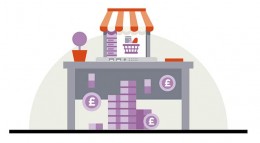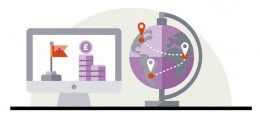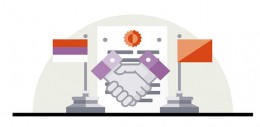Once companies have summoned up the courage to begin selling overseas, their next dilemma is choosing a market entry method. There are numerous tactics available, from simply sticking your products on a giant web platform, to finding an eager distributor, or taking the plunge and buying an overseas partner or competitor.
Most exporters will use some combination of seven core tactics, but which route to choose will depend on the size, stage and type of business trading abroad, as well as the nature of the products. A company with a unique widget they’ve invented may find licensing their technology to a partner is the quickest route to international growth, for example, while a manufacturer may find it’s necessary to open a foreign subsidiary.
New exporters who aren’t quite sure which method to use can ask UK Trade & Investment, the government’s export agency for help. Its First Time Exporters scheme provides training and advice for fledgling global traders, including guidance on which market entry method might hold the key to international success.
1. E-commerce
 Often the simplest and most common starting point for small exporters is to make products and services available online. Selling through your own website, or a giant online platform such as Amazon, eBay or Etsy, allows small businesses to access a global audience instantly without leaving their office, kitchen or bedroom. Those choosing Amazon, for example, can also simplify things even further by using the web giant’s own payments system, warehousing and distribution network. Callum Bush started his electronic accessories business, called Mediadevil, in his bedroom in 2009 with £3,000 capital. He has used Amazon’s distribution services to sell more than one million of his products in markets including Italy, Germany and the United States, and has won an award from UK Trade & Investment for his exporting prowess.
Often the simplest and most common starting point for small exporters is to make products and services available online. Selling through your own website, or a giant online platform such as Amazon, eBay or Etsy, allows small businesses to access a global audience instantly without leaving their office, kitchen or bedroom. Those choosing Amazon, for example, can also simplify things even further by using the web giant’s own payments system, warehousing and distribution network. Callum Bush started his electronic accessories business, called Mediadevil, in his bedroom in 2009 with £3,000 capital. He has used Amazon’s distribution services to sell more than one million of his products in markets including Italy, Germany and the United States, and has won an award from UK Trade & Investment for his exporting prowess.
2. Licensing to a partner
 This is a relatively low-risk, low-cost method of selling products overseas without having to worry about the hassle of managing the everyday details of exporting or investing a significant amount of your own capital upfront. You choose a partner who will often be given a licence to sell your products exclusively in one or more territories for a fixed term and will pay you a royalty fee in return based on a percentage of sales. It can be a way to test the water in a market and pave the way for further investments, but involves choosing your partner very carefully. You won’t have much control, so they’ll need to be doing a good job if your brand isn’t to be damaged. You’ll normally need high sales volumes to see a decent return.
This is a relatively low-risk, low-cost method of selling products overseas without having to worry about the hassle of managing the everyday details of exporting or investing a significant amount of your own capital upfront. You choose a partner who will often be given a licence to sell your products exclusively in one or more territories for a fixed term and will pay you a royalty fee in return based on a percentage of sales. It can be a way to test the water in a market and pave the way for further investments, but involves choosing your partner very carefully. You won’t have much control, so they’ll need to be doing a good job if your brand isn’t to be damaged. You’ll normally need high sales volumes to see a decent return.
3. Franchising
 Similar to licensing, franchising can also be a low-cost way of expanding into a number of markets simultaneously. However, it involves formally “packaging up” the brand, know-how and processes of your business so a partner can easily buy a localised version of your brand “off the shelf”. More than 80 per cent of McDonald’s restaurants are owned by franchisees, allowing small business owners all over the world to operate with the power of a famous brand behind them. While there are various complexities involved, not least the common risk of disagreements and legal disputes with franchisees, smaller, less well-known companies have also used this method to enter markets they couldn’t have tackled on their own.
Similar to licensing, franchising can also be a low-cost way of expanding into a number of markets simultaneously. However, it involves formally “packaging up” the brand, know-how and processes of your business so a partner can easily buy a localised version of your brand “off the shelf”. More than 80 per cent of McDonald’s restaurants are owned by franchisees, allowing small business owners all over the world to operate with the power of a famous brand behind them. While there are various complexities involved, not least the common risk of disagreements and legal disputes with franchisees, smaller, less well-known companies have also used this method to enter markets they couldn’t have tackled on their own.
4. Open a subsidiary
 Opening an entirely new, separate business entity in a key export market sits at the other end of the commitment scale from simply using an online platform to begin selling a few products overseas. Many smaller businesses will shy away from this, at least in their early days, due to the cost, risk and complexity involved. However, where regular close contact with customers and detailed control is required, a wholly owned subsidiary can be a sensible approach, especially in markets expected to contribute a significant chunk of overall sales. It’s common for manufacturers to set up an overseas plant. For example, Direct Healthcare Services, a Welsh maker of pressure care products including specialist mattresses and cushions, has used local subsidiaries to allow it to expand in 20 countries across Europe, Asia-Pacific, Australasia and Latin America.
Opening an entirely new, separate business entity in a key export market sits at the other end of the commitment scale from simply using an online platform to begin selling a few products overseas. Many smaller businesses will shy away from this, at least in their early days, due to the cost, risk and complexity involved. However, where regular close contact with customers and detailed control is required, a wholly owned subsidiary can be a sensible approach, especially in markets expected to contribute a significant chunk of overall sales. It’s common for manufacturers to set up an overseas plant. For example, Direct Healthcare Services, a Welsh maker of pressure care products including specialist mattresses and cushions, has used local subsidiaries to allow it to expand in 20 countries across Europe, Asia-Pacific, Australasia and Latin America.
5. Joint venture
 Where there is political risk or government controls on foreign ownership, or you simply need the expertise of an established local player to get off the ground, a formal partnership with a third party may be necessary. China and the Middle East are both markets where a joint venture is often required. Risks include loss of control and your partner becoming a competitor, but you do stand to benefit from the combined resources of two organisations and local expertise.
Where there is political risk or government controls on foreign ownership, or you simply need the expertise of an established local player to get off the ground, a formal partnership with a third party may be necessary. China and the Middle East are both markets where a joint venture is often required. Risks include loss of control and your partner becoming a competitor, but you do stand to benefit from the combined resources of two organisations and local expertise.
6. Merger/acquisition
 Why start from scratch if you can afford to buy local skills, market share and knowledge by acquiring a company in your target market? Having a presence on the ground that already has customers as well as expertise proves you’re committed for the long term and provides a running start in a new territory. Solar power business Bboxx used this method in order to build sales in a tricky region. In 2013, the company bought out its distribution partners in Kenya and Uganda with a view to establishing a base for expansion. Chris Baker-Brian, the company’s co-founder, says: “This helped us enter a relatively difficult market in a controlled way, balancing the need to control the entire supply chain with the difficulty of operating a business in East Africa by using our distributors’ experience.” Bboxx now has 10,000 customers in the region.
Why start from scratch if you can afford to buy local skills, market share and knowledge by acquiring a company in your target market? Having a presence on the ground that already has customers as well as expertise proves you’re committed for the long term and provides a running start in a new territory. Solar power business Bboxx used this method in order to build sales in a tricky region. In 2013, the company bought out its distribution partners in Kenya and Uganda with a view to establishing a base for expansion. Chris Baker-Brian, the company’s co-founder, says: “This helped us enter a relatively difficult market in a controlled way, balancing the need to control the entire supply chain with the difficulty of operating a business in East Africa by using our distributors’ experience.” Bboxx now has 10,000 customers in the region.
7. Remote distribution
 A very common way to tap local knowledge and contacts, but without the expense or commitment of a more formal joint venture or acquisition, is to find local distributors in each market you target. As well as physically picking up and moving your product, the distributor will also knock on doors on your behalf to build your order book. The Lakes Distillery, a young English whisky, vodka and gin distillery, is using this method to supply France, Spain, Germany and Taiwan. Founder Paul Currie says he generally picks small distributors because emerging companies of a similar size to your own are often more eager to do a good job than big-name local resellers, where your product risks merely being one of many they are pushing.
A very common way to tap local knowledge and contacts, but without the expense or commitment of a more formal joint venture or acquisition, is to find local distributors in each market you target. As well as physically picking up and moving your product, the distributor will also knock on doors on your behalf to build your order book. The Lakes Distillery, a young English whisky, vodka and gin distillery, is using this method to supply France, Spain, Germany and Taiwan. Founder Paul Currie says he generally picks small distributors because emerging companies of a similar size to your own are often more eager to do a good job than big-name local resellers, where your product risks merely being one of many they are pushing.
1. E-commerce

2. Licensing to a partner

